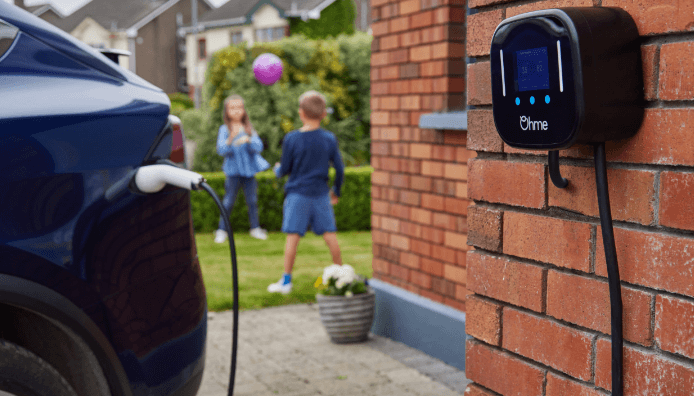How can I install electric car charger at home and in office building?

As the world shifts towards sustainable transportation solutions, the rise of electric vehicles (EVs) has become a defining trend in the automotive industry. With their environmental benefits and cost savings, EVs are gaining popularity among consumers.
However, to truly embrace electric mobility, the infrastructure supporting it must evolve as well. One pivotal aspect of this evolution is EV charger instillation, both at home and in office buildings.
In this article, we embark on a journey to understand the intricacies of installing EV chargers. From the comfort of home to the bustling environment of office buildings, we explore the steps, considerations, and challenges involved in setting up charging infrastructure.
By empowering individuals and organisations with the knowledge to navigate this process, we contribute to the acceleration of electric mobility adoption and the transition towards a sustainable future.
Introduction to Electric Car Charging Infrastructure:
Electric car charging infrastructure comprises various types of chargers, ranging from Level 1 chargers (standard household outlets) to Level 3 chargers (fast DC chargers).
For residential and office installations, Level 2 chargers are the most common choice due to their faster charging speeds and compatibility with most EVs.
Installing Electric Car Chargers at Home:
Step 1: Assessing Your Electrical System
Before you install electric car charger at home, it’s essential to assess your electrical system’s capacity. A licensed electrician can help determine if your existing electrical panel can support the additional load of an EV charger or if an upgrade is necessary.
Step 2: Choosing the Right Charger
Selecting the right charger depends on factors such as your vehicle’s charging capabilities, desired charging speed, and budget. Level 2 chargers typically provide charging speeds of 15-30 miles of range per hour, making them suitable for overnight charging at home.
Step 3: Locating the Charging Station
Decide on the optimal location for installing the charging station. Consider factors such as proximity to your parking space, accessibility, and ease of installation. Garages or carports are popular choices for home EV charger installations, providing protection from the elements.
Step 4: Obtaining Permits and Approvals
Check local regulations and obtain any necessary permits before installing the EV charger. Depending on your location, you may need approval from your homeowners’ association or local authorities.
Step 5: Installation Process
Hire a qualified electrician to install the charging station following manufacturer guidelines and local electrical codes. This typically involves mounting the charger, running electrical wiring from the electrical panel to the charging location, and connecting the charger to the power supply.
Step 6: Testing and Commissioning
Once installed, test the charger to ensure its functioning correctly and safely. Verify that the EV charger communicates with your vehicle and that all safety features are operational.
Step 7: Maintenance and Support
Regular maintenance of the EV charger is essential to ensure optimal performance and safety. Periodically inspect the charger for any signs of wear or damage, and schedule professional servicing as needed.
Installing Electric Car Chargers in Office Buildings
Step 1: Conducting a Site Assessment
Before proceeding with the installation of EV chargers in an office building, conduct a thorough site assessment to determine the feasibility and requirements. Consider factors such as available parking spaces, electrical capacity, and anticipated demand for EV charging.
Step 2: Planning Charger Placement
Identify suitable locations for installing EV chargers within the office building’s premises. Ideally, chargers should be conveniently located near parking spaces and easily accessible to employees and visitors.
Step 3: Upgrading Electrical Infrastructure
Evaluate the building’s electrical infrastructure to ensure it can support the additional load of multiple EV chargers. In some cases, upgrades to the electrical panel or wiring may be necessary to accommodate the increased demand.
Step 4: Selecting Charging Equipment
Choose the appropriate charging equipment based on the anticipated usage patterns and requirements of the office building. Consider factors such as charging speed, scalability, and compatibility with different EV models.
Step 5: Obtaining Permits and Approvals
Obtain necessary permits and approvals from local authorities and building management before proceeding with the installation. Compliance with building codes and regulations is crucial to ensure the safety and legality of the EV charging infrastructure.
Step 6: Installation and Commissioning
Engage qualified contractors or electricians to install the EV chargers according to manufacturer guidelines and industry best practices. Thorough testing and commissioning should be carried out to verify the functionality and safety of the charging stations.
Step 7: Implementing User Management Systems
Consider implementing user management systems or software to track usage, manage access, and facilitate billing for EV charging services. This can help optimize the use of charging infrastructure and provide insights into energy consumption patterns.
Step 8: Providing Ongoing Support and Maintenance
Establish a maintenance schedule to ensure the ongoing performance and reliability of the EV charging infrastructure. Regular inspections, servicing, and software updates are essential to address any issues promptly and maintain user satisfaction.
Factors to consider when installing electric car charger at home and in office building:
Installing electric car chargers at home and in office buildings can greatly contribute to the widespread adoption of EVs. However, there are several crucial factors that must be considered to ensure the successful electric vehicle charging station installation and operation of these chargers. We will explore the key considerations for installing electric car chargers in both residential and commercial settings.
1. Understanding Electric Car Charging Options:
Before delving into the installation process, it’s essential to understand the different types of electric car chargers available. The three main types are Level 1, Level 2, and Level 3 chargers, each offering varying charging speeds and compatibility with different EV models. Level 1 charger utilizes a standard 120-volt household outlet and is suitable for overnight charging.
The Level 2 chargers require a 240-volt circuit and offer faster charging rates, making them ideal for home and office installations. Level 3 chargers, also known as DC fast chargers, are designed for rapid charging and are typically found in public charging stations.
2. Assessing Electrical Capacity:
One of the most critical factors to consider when installing electric car chargers is the electrical capacity of the location. Both residential and commercial buildings must have sufficient electrical infrastructure to support the additional load of EV charging.
An electrician should conduct a thorough assessment to determine if the existing electrical system can accommodate the installation of a charger or if upgrades are required. Factors such as the size of the electrical panel, available circuit capacity, and wiring adequacy need to be evaluated to ensure safety and compliance with local building codes.
3. Choosing the Right Location:
Selecting the optimal location for electric car chargers is crucial for convenience, accessibility, and safety. In residential settings, the charger should be installed in a location that allows for easy access and manoeuvrability, such as a garage or driveway. For office buildings, charging stations should be strategically placed in parking areas with sufficient space and clear signage to indicate their presence.
Additionally, consideration should be given to factors such as weather protection, lighting, and security to enhance the user experience and protect the equipment from damage or theft.
4. Evaluating Charging Equipment:
When selecting charging equipment for home or office installations, it’s essential to choose reliable, high-quality products from reputable manufacturers. Factors to consider include charging speed, compatibility with different EV models, durability, and warranty coverage.
Level 2 chargers come in various configurations, including wall-mounted units and pedestal-mounted stations, offering flexibility in installation and usage. It’s also worth considering smart charging features such as Wi-Fi connectivity, mobile app integration, and billing capabilities for enhanced functionality and user convenience.
5. Considering Future Expansion:
As the popularity of electric vehicles continues to grow, it’s important to plan for future expansion when installing charging infrastructure. Homeowners and building owners should assess their long-term needs and consider factors such as potential increases in EV ownership, advancements in charging technology, and changes in regulatory requirements.
Installing wiring and infrastructure capable of supporting additional chargers or higher charging capacities can help future-proof the installation and minimise the need for costly upgrades down the line.
6. Ensuring Compliance and Safety:
Compliance with local regulations and safety standards is paramount when installing electric car chargers. Homeowners and building owners should consult with local authorities and obtain any necessary permits before proceeding with the installation.
Additionally, hiring a licensed electrician experienced in EV charger installations is recommended to ensure that the work is done safely and in accordance with relevant codes and guidelines. Proper grounding, circuit protection, and equipment installation are essential to prevent electrical hazards and ensure the reliable operation of the charging infrastructure.
7. Considering Financial Incentives:
Several financial incentives and rebates may be available to homeowners and businesses to offset the cost of installing electric car chargers. These incentives vary depending on location and may include tax credits, grants, utility rebates, and low-interest financing programs.
By taking advantage of these incentives, homeowners and building owners can reduce the upfront costs of installation and accelerate the return on investment of their charging infrastructure. Additionally, installing electric car chargers can enhance property value and appeal to environmentally conscious tenants or buyers.
Conclusion:
Installing electric car chargers at home and in office buildings is a crucial step towards supporting the transition to electric mobility. By following the outlined steps and considerations, homeowners and building owners can create convenient and efficient charging solutions that encourage the widespread adoption of electric vehicles. With the right planning, implementation, and maintenance, electric car charging infrastructure can contribute to a sustainable transportation future.
This comprehensive guide serves as a road map for individuals and organisations looking to install EV chargers, empowering them to make informed decisions and navigate the installation process successfully. As electric vehicles continue to gain momentum, investing in robust charging infrastructure is key to driving positive environmental and societal impacts for generations to come.




